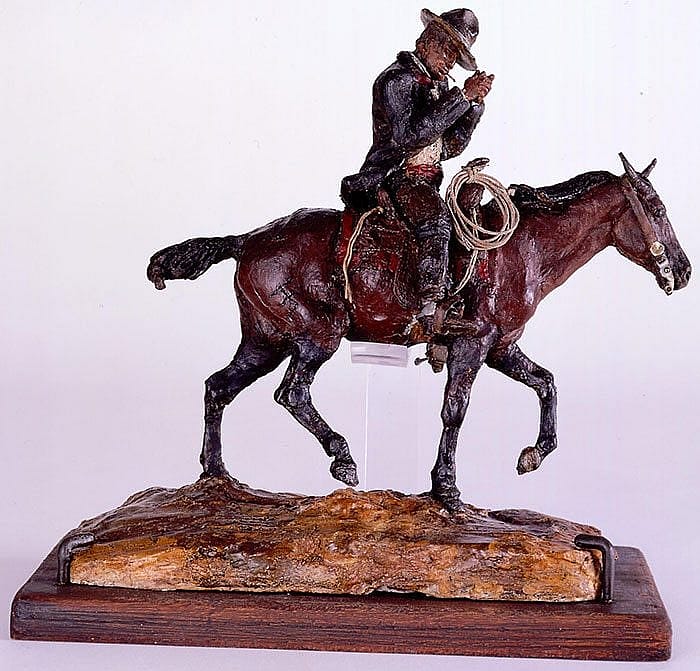
Conservation of Russell waxes reveals their original appearance – Points West Online
Originally published in Points West magazine
Winter 1993
Conservation of Russell Waxes Reveals Their Original Appearance
By Sarah E. Boehme
Former Curator, Whitney Western Art Museum
In 1993, a second grant of $10,000 from the Charlie Russell Riders Foundation supported conservation of a group of rare Charles M. Russell wax sculptures. The project not only conserved the works of art, but also revealed new information about the original appearance of Russell’s works of art.
The Whitney collection includes more than sixty wax and plaster sculptures by Russell. Most of these were removed from exhibition in 1986 because of their condition. Some of the waxes appeared to be deteriorating, developing a sticky brown liquid on their surfaces which made them appear to be melting. Consequently, the Russell waxes were identified as priorities for conservation treatment.
Research has revealed that much of the deterioration is caused by alterations to the sculptures after C.M. Russell’s death. Most of these wax sculptures can be traced to the estate of Nancy Russell, the wife of the artist. Rick Stewart, Amon Carter Museum curator, has identified photographs documenting the appearance of the waxes when Nancy Russell’s estate was settled. In many cases, waxes were altered by the collectors who cast them into bronze after acquiring them from Nancy Russell’s collection.
C.M. Russell used grasses, wood, fabric, and other materials to create these figures; he also painted the surfaces. The artist probably never intended to cast these pieces in bronze; they were conceived as unique pieces, drawn from his imagination, and made as gifts for family and friends.
The conservation treatment of Lunch Hour, a wax and wood sculpture, illustrates the extent of this project. Russell made this sculpture using a piece of wood for the tree and beeswax to model the bear family. The photograph of Lunch Hour taken for the Nancy Russell estate shows that Russell had made the large bear’s claws from pieces of tin and that the wood stump had deep hollow areas. These details are not evident in the bronze casts.
Examination of Lunch Hour showed that material had been added to Russell’s original sculpture. Plasticine, a modeling clay, was used to fill in parts of the sculpture, probably to make it easier to cast. Deterioration of the plasticise, which is less stable than beeswax, caused the sticky brown liquid to form on the surface.
For the Russell project, the Center commissioned a sculpture conservator, Glenn Wharton of Santa Barbara, California, who, in consultation with [then former] staff conservator Beverly Perkins and myself as curator, cleaned Lunch Hour by hand and with solvents where appropriate. The plasticise was removed, revealing the tin claws, the shape of the wood, and Russell’s delicate coloring. The work of art was restored as closely as possible to Russell’s original conception and its condition was stabilized to preserve it.

Grants from the Charlie Russell Riders Foundation and Armand Hammer funded the treatment of twelve sculptures and partial completion of five others. This second grant from the Russell Riders completed the treatment and initiated conservation on eight more sculptures. The Russell Riders are a philanthropic group from across the United States, who, like their namesake, seek to preserve the West through art and education programs. The organization was founded in 1985 and in its first years supported the C.M. Russell Museum in Great Falls. In 1989, their mission expanded to consider other projects related to Russell.
Post 047
Written By
Nancy McClure
Nancy now does Grants & Foundations Relations for the Center of the West's Development Department, but was formerly the Content Producer for the Center's Public Relations Department, where her work included writing and updating website content, publicizing events, copy editing, working with images, and producing the e-newsletter Western Wire. Her current job is seeking and applying for funding from government grants and private foundations. In her spare time, Nancy enjoys photography, reading, flower gardening, and playing the flute.












